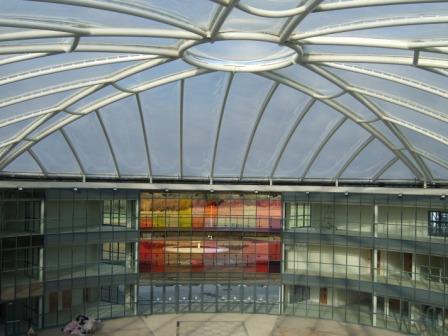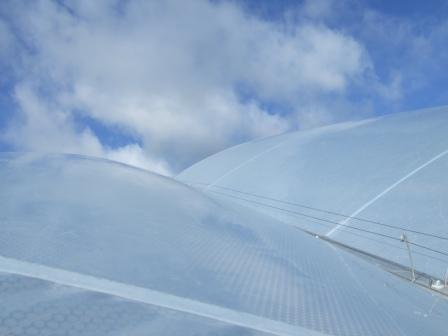One of the most exciting materials in the design industry Ethylene Tetra Fluoro Ethylene (ETFE) foil has set the construction world alight with the huge range of potential applications.

The possible uses for ETFE foil have vastly expanded since its invention for use in aeronautics 30 years ago. It has evolved dramatically as a mainstream building material, best seen on the eye-catching North West Bus Interchange at London’s Westfield Shopping Centre.
ETFE roofs are created by extruding ETFE film to create a material with high corrosion resistance and strength over a wide temperature range; it can then be used as a single ply material or engineered into air-filled cushions supported by perimeter frames.
Single Ply ETFE:

Single ply ETFE provides minimal insulation but maximum light, so tends to be used to create inside/outside areas. For this purpose it has frequently been installed in schools all over the country to provide rain protection to street areas and external teaching spaces.
ETFE Cushions:

As well as being a low flammability material, the ETFE foil is also self-extinguishing which means it is a good option when health and fire safety is a specific concern, for example New Cavendish Street uses a hot wire system to control smoke in the event of a fire.
The foil itself can also be engineered to help control and adapt to solar glare, as seen at the North Swindon School. Here the foil is printed (or fritted) with a pattern to provide glare reduction. Alternatively, by adding additional layers of ETFE foil to a cushion, light transmission and solar gain can be controlled. Multi-layer ETFE cushions can also be constructed. These incorporate movable layers and intelligent (offset) printing. By alternatively pressurising individual chambers within the cushion, we can achieve maximum shading and reduce shading when required. Essentially this means that it is possible to create a building skin which is reactive to its environment.
A glimpse of the exciting future ETFE offers is the Allianz Arena football stadium in Munich, where the inflated cushions are lit internally with LED lighting to make them glow varying colours. Other major projects around the globe include the stunning Water Cube Olympic arena in Beijing, built specifically for the 2008 Olympic Games and the Eden Project in Cornwall, which was the first UK structure to use ETFE cushions.
With a lifespan of more than 30 years ETFE foil is unaffected by UV light, environmental weathering and pollution and does not become brittle or discoloured over time, ensuring it is a building material here for the long term. Exciting times lie ahead with ETFE foil as ETFE increasingly becomes a vital material in the construction industry.
Other posts by Architen Landrell